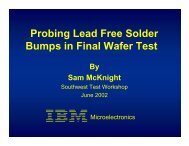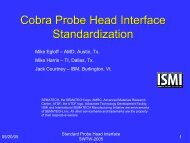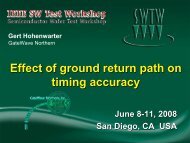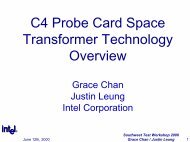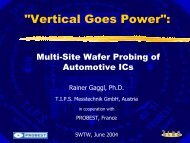A Flexible Vertical MEMs Probe Card Technology for Pre-Bump and ...
A Flexible Vertical MEMs Probe Card Technology for Pre-Bump and ...
A Flexible Vertical MEMs Probe Card Technology for Pre-Bump and ...
You also want an ePaper? Increase the reach of your titles
YUMPU automatically turns print PDFs into web optimized ePapers that Google loves.
June 12 to 15, 2011<br />
San Diego, CA<br />
A <strong>Flexible</strong> <strong>Vertical</strong> <strong>MEMs</strong> <strong>Probe</strong><br />
<strong>Card</strong> <strong>Technology</strong> <strong>for</strong> <strong>Pre</strong>‐<strong>Bump</strong> <strong>and</strong><br />
eWLP Applications<br />
Mike Slessor<br />
Rick Marshall<br />
(Micro<strong>Probe</strong>, Inc.)
<strong>Vertical</strong> MEMS <strong>for</strong> <strong>Pre</strong>‐<strong>Bump</strong> <strong>Probe</strong><br />
• Introduction: eWLP <strong>and</strong> <strong>Pre</strong>‐<strong>Bump</strong> Probing Requirements<br />
• Experiment Objectives & Details<br />
– Accurate Probing on Small Pads at Fine Pitch<br />
– Low Scrub Depth on <strong>Pre</strong>‐<strong>Bump</strong> Pads<br />
– Wafers <strong>Probe</strong>d & Measurements Taken<br />
• Observed <strong>Probe</strong> Results & Conclusions<br />
– Accuracy & Repeatability Across Wafer<br />
– Measured Scrub Depth Results<br />
– Reliable Enabling of <strong>Pre</strong>‐<strong>Bump</strong> Probing <strong>for</strong> Improved eWLP Yields<br />
• Follow‐On Work<br />
– Production Characterization in Large Volume<br />
• Summary<br />
June 12 to 15, 2011<br />
IEEE SW Test Workshop 2
Micro<strong>Probe</strong>: A Leading Supplier of<br />
Logic/RF/SoC <strong>Probe</strong> <strong>Card</strong> Solutions<br />
Innovation <strong>and</strong> Growth<br />
• <strong>Technology</strong> Leadership<br />
– >1000 MEMS probe cards delivered<br />
• Market Share Growth<br />
– #1 supplier of Advanced SoC <strong>Probe</strong> <strong>Card</strong>s<br />
• Customer Collaboration<br />
– 35‐year history of delivering results<br />
Breadth <strong>and</strong> Stability<br />
• Broad Product Portfolio<br />
– Cantilever, <strong>Vertical</strong>, <strong>and</strong> MEMS<br />
• Global <strong>Pre</strong>sence<br />
– Major facilities in China, Taiwan, US<br />
• Strong Institutional Investors<br />
– Flywheel Ventures, Gemini Investors, Intel Capital<br />
June 12 to 15, 2011<br />
IEEE SW Test Workshop 3
eWLP Resurrects <strong>Pre</strong>‐<strong>Bump</strong> Array Probing<br />
• While pre‐bump probing has been largely eliminated from<br />
mature BGA Flip‐Chip p packaging g flows, the workflow <strong>and</strong> cost<br />
considerations of eWLP are re‐introducing need <strong>for</strong> effective<br />
pre‐bump probing on arrays of aluminum pads.<br />
• Today’s designs challenge hll probing on multiple l fronts:<br />
– Full‐grid array layout at ~100um pitches → <strong>Vertical</strong> Architecture<br />
– Small pads <strong>and</strong> pad openings → Small Scrub<br />
– Low‐k dielectrics <strong>and</strong> under‐pad circuitry → Low Force<br />
• Experimental work demonstrates that Micro<strong>Probe</strong>’s MEMS<br />
<strong>Vertical</strong> probe solution addresses today’s pre‐bump probe<br />
requirements, enabling cost‐effective implementation of<br />
newly developed eWLP‐based packaging flows.<br />
June 12 to 15, 2011<br />
IEEE SW Test Workshop 4
What is eWLP?<br />
• eWLP= “Embedded Wafer Level Packaging”<br />
• eWLP is an evolution of BGA‐type packaging that uses molded<br />
carriers <strong>and</strong> fan‐out RDLs. The original die are singulated,<br />
embedded into molded carriers, <strong>and</strong> then reconstituted onto<br />
artificial i wafers. Wafer‐level Wf lprocesses then add redistribution<br />
ib ti<br />
layers (RDLs) <strong>and</strong> solder balls<br />
• This approach enables both a higher level<br />
of interconnects per die area (due to the<br />
fan‐out RDL) <strong>and</strong> enables greatly<br />
simplified multi‐chip integration.<br />
• Also known as eWLB (Wafer‐Level BGA)<br />
A Simplified eWLP Stack‐Up<br />
<strong>and</strong> FO‐WLP (Fan‐Our WLP)<br />
June 12 to 15, 2011<br />
IEEE SW Test Workshop 5
eWLP <strong>and</strong> <strong>Pre</strong>‐<strong>Bump</strong> <strong>Probe</strong><br />
• Packaging bad die into molded carriers, <strong>and</strong> subsequently<br />
attaching them to reconstituted wafers, causes very expensive<br />
yield loss <strong>for</strong> the final eWLP wafer.<br />
• For multi‐die eWLP packages, the cost impact is even worse –the<br />
problem is directly analogous to test tescapes finding their way<br />
into a multi‐chip module.<br />
• Because of these considerations,<br />
effective test of the target die<br />
prior to singulation is imperative<br />
to ensure good yield at final test.<br />
June 12 to 15, 2011<br />
IEEE SW Test Workshop 6
Example eWLP Test Flow<br />
Die A<br />
Wafer Sort<br />
Die B<br />
Wafer Sort<br />
Die C<br />
Wafer Sort<br />
Dice Wafer / Singu ulation<br />
Integration of<br />
Good Die Into<br />
Molded Carrier<br />
Reconstitution<br />
Into Artificial<br />
Wafer<br />
Redistribution<br />
Layers (RDL)<br />
Printed<br />
Solder Ball / Cu<br />
Pillar Attach<br />
Final Test<br />
June 12 to 15, 2011<br />
IEEE SW Test Workshop 7
<strong>Pre</strong>‐<strong>Bump</strong> <strong>Probe</strong> Challenges<br />
•Fine Pitch in Full Grid Arrays<br />
– RDL fan‐out permits increasingly gyfine pitch across high<br />
pincount arrays. Today’s arrays are 130um – 180um. Next<br />
generation arrays will be < 100um.<br />
• Small llPd Pads<br />
–Bond pad openings are getting smaller: 50um octagonal pads<br />
are migrating towards 40um<br />
•Low Force<br />
– CUP <strong>and</strong> Low‐K require very low<br />
<strong>for</strong>ce contact on the pad material<br />
to ensure there is no IC damage<br />
Passivation<br />
Active Circuitry<br />
Under Pads<br />
Low-k dielectric ILD<br />
Passivation<br />
June 12 to 15, 2011<br />
IEEE SW Test Workshop 8
Micro<strong>Probe</strong> <strong>Vertical</strong> MEMS “Mx”<br />
<strong>Probe</strong> Architecture<br />
• Composite MEMS structure allows<br />
optimization of mechanical <strong>and</strong><br />
electrical design<br />
– Multiple materials & Layers<br />
– Photolithographically hi ll Dfi Defined dShape<br />
• Resulting material &geometry<br />
flexibility provides optimal contact<br />
per<strong>for</strong>mance <strong>and</strong> pitch scalability<br />
June 12 to 15, 2011<br />
Mx‐FP <strong>Probe</strong><br />
Low‐K / CUP<br />
Pointed <strong>Probe</strong><br />
Al & Cu Pads<br />
Flat <strong>Probe</strong><br />
Cu Pillars, <strong>Bump</strong>s<br />
IEEE SW Test Workshop 9
Customer Experiments with Mx<br />
<strong>for</strong> <strong>Pre</strong>‐<strong>Bump</strong> Probing<br />
•Customer A: Focus on low <strong>for</strong>ce contact to minimize<br />
pressure applied to circuit itunder pad<br />
•Customer B: Focus on good contact with minimal<br />
scrub depth into pad material<br />
scrub depth into pad material<br />
•Customer C: Focus on probe<br />
tip accuracy <strong>for</strong> contacting<br />
small pads with high<br />
precision <strong>and</strong> repeatability<br />
Example Mx <strong>Probe</strong> Head<br />
with > 10K MEMS <strong>Probe</strong>s<br />
June 12 to 15, 2011<br />
IEEE SW Test Workshop 10
Customer A: Low Force Experiment<br />
• Wafer Setup <strong>for</strong> Experiment<br />
– 300mm wafer at 40nm process<br />
– eWLP pre‐bump pads probing<br />
– 60um octagonal pads<br />
• Evaluation Criteria<br />
– Cres must be within acceptable range <strong>for</strong> device<br />
– <strong>Probe</strong> <strong>for</strong>ce over active area <strong>and</strong> low‐k ILD must be minimal<br />
– Scrub mark must be small <strong>and</strong> repeatable<br />
June 12 to 15, 2011<br />
IEEE SW Test Workshop 11
Mx <strong>Probe</strong> Contact Force at Overtravel<br />
8.00<br />
<strong>Probe</strong> Contact Force<br />
7.00<br />
6.00<br />
Contact Force (g g)<br />
500 5.00<br />
4.00<br />
3.00<br />
2.00<br />
FC‐150<br />
FP‐60<br />
FP‐50<br />
1.00<br />
000 0.00<br />
0 10 20 30 40 50 60 70 80 90 100<br />
Overtravel (um)<br />
Recommended OT = 65um<br />
June 12 to 15, 2011<br />
IEEE SW Test Workshop 12
Mx Low‐Force Design & Modeling<br />
• MEMS Geometry & Metallurgy<br />
– Proprietary Mx MEMS process enables multi‐layer<br />
probe design with lithographically hi ll dfi defines shapes<br />
– Focused on low‐<strong>for</strong>ce mechanical design<br />
while maintaining excellent Cres characteristics<br />
• Design & Modeling<br />
– Detailed FEA models are developed to predict scrub stress behavior<br />
– Model predictions are continually refined based on real‐world observation<br />
2g contact <strong>for</strong>ce<br />
4g contact <strong>for</strong>ce<br />
June 12 to 15, 2011<br />
IEEE SW Test Workshop 13
Customer A: Low Force Findings<br />
• Mx scrub mark ranges 8um – 15um<br />
• Maximum scrub depth of 0.55um<br />
– (After 8 touchdowns)<br />
Mx‐FP Scrub<br />
Length of<br />
~10um<br />
Cantilever<br />
Scrub Length<br />
of >30um<br />
• No ILD cracking found with 60um over‐drive<br />
12.1um<br />
8.9um<br />
June 12 to 15, 2011<br />
IEEE SW Test Workshop 14
Customer B: Small Pads Experiment<br />
• Test Setup <strong>for</strong> Experiment<br />
– ≈180 Die Per Wafer<br />
– ≈ 7,500 Pads Contacted per Die<br />
– 55um Pads in 180um Array<br />
– TEL P12Ln <strong>Probe</strong>r with Test Temperature of 40degC<br />
June 12 to 15, 2011<br />
IEEE SW Test Workshop 15
Scrub Mark Size & Accuracy<br />
• Customer Findings on Scrub Mark Placement<br />
– Typical accuracy to pad center: +/‐ 9um<br />
– Worst‐case accuracy observed: +20um<br />
– (Mx Typical Spec = +/‐13um)<br />
• Customer Findings on Scrub bMark kSize<br />
– 20um OD 7um Scrub<br />
– 30um OD 10um Scrub<br />
– 50um OD 11um Scrub<br />
– 65um OD 15um Scrub<br />
– (Mx Recommended OD = 65um)<br />
50um OD<br />
30um OD<br />
20um OD<br />
65um OD<br />
June 12 to 15, 2011<br />
IEEE SW Test Workshop 16
Accuracy & Repeatability Across Wafer<br />
Die = ‐5, 0<br />
Die = ‐1, 0<br />
Die = 0, ‐6<br />
Die = 0, 5<br />
Die = 6, 0<br />
June 12 to 15, 2011<br />
IEEE SW Test Workshop 17
Customer B: Small Pads Findings<br />
• Mx solution delivers highly‐accurate <strong>and</strong> repeatable scrub marks<br />
that are suitable <strong>for</strong> pre‐bump p probing small pads<br />
– Overall planarity of a large array was very good (< 24um)<br />
– <strong>Probe</strong> mark placement was very accurate, consistently placing the scrub<br />
center within +/‐ 13um. (One outlier was observed.)<br />
– Placement across 300mm wafer was extremely repeatable<br />
– Tip recognition, cleaning requirements, etc., are production‐worthy<br />
June 12 to 15, 2011<br />
IEEE SW Test Workshop 18
Customer C: Scrub Depth Experiment<br />
• Wafer Setup <strong>for</strong> Experiment<br />
– 300mm qual wafer selected in Engineering lab<br />
– Entire wafer probed with 4 touchdowns on every die<br />
– Lower 2/3 probed with a 5 th touchdown<br />
– Lower 1/3 probed with a 6 th touchdown<br />
• Scrub Mark Review Techniques<br />
– Center <strong>and</strong> edge samples collected from each zone<br />
– Angled photos tk taken to profile scrub mark shape<br />
– Passivation cap added to enable FIB cross‐sectioning<br />
– Scrub depth into Aluminum directly measured<br />
June 12 to 15, 2011<br />
IEEE SW Test Workshop 19
Customer C: Scrub Depth Findings<br />
• Pad Scrub Findings<br />
– Starting aluminum depth of 1.20um<br />
– Worst‐case image: 6 touchdowns at wafer center<br />
– Aluminum depth of 0.64um shows maximum scrub depth of 0.56um<br />
– Low scrub was very repeatable across all wafer zones<br />
Passivation (<strong>for</strong> FIB)<br />
1.20um<br />
2.85um<br />
0.64um<br />
Wafer Base<br />
Aluminum<br />
June 12 to 15, 2011<br />
IEEE SW Test Workshop 20
• Conclusion<br />
Conclusions & Use Benefits<br />
– The Mx MEMS vertical probe solution addresses key requirements <strong>for</strong><br />
today’s pre‐bump probing: low‐<strong>for</strong>ce, high‐accuracy h contact, t repeatability,<br />
<strong>and</strong> low <strong>for</strong>ce. These characteristics can enable effective pre‐bump probe<br />
<strong>for</strong> the next generation of pads testing.<br />
• Use Benefits<br />
– Flows such as eWLP can significantly reduce packaging costs by ensuring<br />
only known good die are put into molded carriers & reconstituted wafers<br />
– Yield learning & improvement can be accelerated by bringing “first look”<br />
closer to the wafer fab –no need to wait <strong>for</strong> bumping to see low yield<br />
– Long‐term quality & reliability of pads‐tested devices can be improved by<br />
reducing the risk that under‐pad circuitry is stressed or damaged<br />
June 12 to 15, 2011<br />
IEEE SW Test Workshop 21
• Follow‐On Work<br />
Follow‐On Work / Q&A<br />
– Lifetime testing on accuracy <strong>and</strong> scrub would be beneficial to underst<strong>and</strong><br />
MEMS stability <strong>and</strong> repeatability versus legacy solutions<br />
– Copper pads testing should be conducted –these studies were<br />
all done using Aluminum pads<br />
– Additional hot‐temp testing would be useful, as would a cold‐temp study<br />
• Questions?<br />
Mx‐FP<br />
June 12 to 15, 2011<br />
IEEE SW Test Workshop 22



